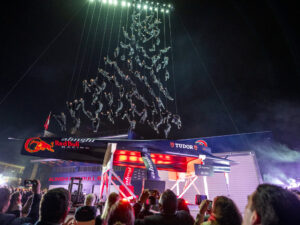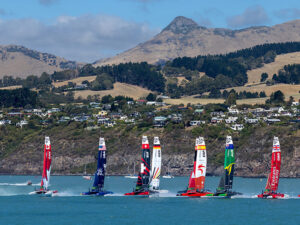School: Hobart/William Smith Colleges
Geneva, N.Y., 1,800 students.
Sailing Site: North end of Seneca Lake.
Coaching Situation: Full-time head coach, Scott Iklé (Hobart 84), plus part-time assistant coach.
Boats/Facilities: 16 420s, 6 FJs, 2 Lasers, 1 Soling. Boathouse and docks.
Funding: Well-supported both by the college and a developing alumni fund.
Program Profile: Iklé took over a struggling club program in 1993 and has turned it into a winner. While HWS still doesnt have the national recognition or recruiting pull of some of the perennial powers, Iklé is developing a reputation as a very good coach who can create–rather than just attract–great sailors. Iklé runs a tight ship: no drinking at regatta parties, mandatory practice attendance, a rigorous off-season conditioning program. But its hard to argue with his results. He makes no cuts, but usually a quarter of the 40 people who sign up each fall will weed themselves out by spring. Iklé loves his PHDs–poor, hungry, and driven. Youth-sailing rock stars will be sorely disappointed if they arrive in Geneva expecting preferential treatment.
Did you know? HWS alumnus Andy Horton won a gold medal at the 1999 Pan-Am Games.
Comparable Programs: Washington College (MD), Bowdoin, Christopher Newport, Georgetown.
School: University of Washington
Seattle, 25,000 students.
Sailing Site: Lake Union and Lake Washington.
Coaching Situation: Volunteer coach, Scott Leppert (St. Marys 95).
Boats/Facilities: 3 FJs, 5 Lasers. Use of Seattle YCs facilities, including the 8 420s and 15 Lasers.
Funding: Money comes from a variety of sources, including a growing alumni network. The team attended a few Atlantic Coast intersectionals and two nationals last spring.
Program Profile: The Northwest has long been the weakest district in the ICYRA. Its fairly isolated and has never been able to gather significant momentum. However, Leppert is an experienced sailor who occasionally travels with his team to intersectionals. The three NWICYRA schools who compete regularly, Oregon, Washington, and Western Washington, are closer as a group than some big teams. While the NWICYRA gets only one spot at nationals and a few intersectional berths each year, theres not much competition for these spots. Leppert says the Northwest is getting stronger, but for the immediate future, the competitive regattas are all still at least a long drive away. While Leppert is dedicated to the team, the district, and making sure both survive and continue to grow, the NW could stumble if he leaves and isnt replaced.
Did you know? Olympic gold medalist Carl Buchan and bronze medalist Charlie McKee were both All-America selections from Washington.
Comparable Programs: Northwestern, Vermont, Florida, Florida Tech, Western Michigan, Iowa.
School: University of California-Irvine
15,000 students
Sailing Site: Newport Harbor.
Coaching Situation: Part-time head coach, Jonathan Posner [UCI 96], plus an assistant coach.
Boats/Facilities: 8 FJs, 4 Lasers, 8 Shields. A sailing center.
Funding: A recent referendum has significantly increased the teams funding, which was fairly meager until this year. Posner is working to build an endowment.
Program Profile: UCI was consistently one of the strongest programs in the country from the late 80s through the mid 90s, but it has fallen off dramatically in the last few years. Despite the great location, Newport Harbor, and excellent facilities, the local talent–Newport Harbor High School is right down the road–has gone elsewhere. For some people, the ability to sail year-round in shorts is all they need to hear. UCI is a small team, so the opportunity to sail is there. As a varsity sport, sailing has some pull with the admissions office and access to all the varsity trainers and facilities.
Did you know? UCI finished second in dinghy nationals in 1996 and third in 1995.
Comparable Programs: UC-Santa Barbara, South Florida, Eckerd.
School: Purdue University
West Lafayette, Ind., 30,800 students.
Sailing Site: Lake Schafer, a 40-minute drive from campus.
Coaching Situation: Student coached.
Boats/Facilities: 6 FJs, 4 Lasers. Boathouse and a dock.
Funding: The club draws funding from a variety of sources and is fairly well supported.
Program Profile: After lapsing nearly into oblivion during the middle part of the decade, the team has made a strong comeback. Even though the long drive to the boathouse has kept the team from practicing during the week, Purdue could arguably be the best team in the Midwest. The nucleus is strong and young, the funding is adequate, and team captain Darius Barkauskas says theyre actively looking for a sailing site closer to campus.
Did you know? Before being christened as the Boilermakers in the early 1890s, the Purdue football team was occasionally known as the “Cornfield Sailors.”
Comparable Programs: Michigan, Wisconsin, Minnesota, Baylor, Texas, Texas A & M, UC-Berkeley.
School: Texas A & M University at Galveston
1,111 students.
Sailing Site: Offats Bayou.
Coaching Situation: Volunteer head coach, Professor Gerard Coleman (Navy 80)
Boats/Facilities: 12 420s, 10 Sunfish. A pair of sheds for boat storage and repair, floating docks.
Funding: The college bought the boats in one fell swoop and provides some of the teams operating expenses. The rest comes from donations and lab fees from sailing PE classes.
Program Profile: TAMUG has a great sailing site with a consistent sea breeze and a relatively new fleet of boats. Coleman, a two-time Olympic alternate in the Soling class (1988 and 1996) and three-time collegiate All-America selection, has produced some solid regional results despite the fact few of the sailors on his team had sailed prior to college. The school is centrally located in the large SEISA district, six hours from both New Orleans and Dallas. TAMUG is a small school that focuses mainly on marine-specific majors. Though well-ranked academically, its probably not the place for someone who doesnt quite know what he or she wants to study, as the academic options are limited.
Did you know? Sailing is TAMUGs only varsity sport.
Comparable Programs: Mass. Maritime, Maine Maritime, SUNY Maritime, University of Southern Maine, Salve Regina University, Hampton University, Mitchell College.
School: University of New Orleans
16,000 students.
Sailing Site: Lake Ponchartrain.
Coaching Situation: Student coached.
Boats/Facilities: 6 420s [new this fall], boats are launched off a beach.
Funding: None. Team members must pay for everything. An alumni network is being developed.
Program Profile: Essentially just three years old, the UNO squad has already cracked the Sailing World top 20. The Privateers won the SEISA dinghy championships by a good margin last spring. The school is 20 minutes from the French Quarter and for those who can deal with the distractions, New Orleans is a great place to live and go to school. The team is small, meaning that anyone willing to show some dedication will get a chance to sail, and new boats will only make the team more competitive. UNO is in some ways a much less expensive equivalent to better-known Tulane. But, the team is still young and captain Gilly Chamberlains graduation will leave the team with a big void to fill in terms of leadership.
Did you know? UNO has the No. 1 undergraduate Naval Architecture program in the country.









